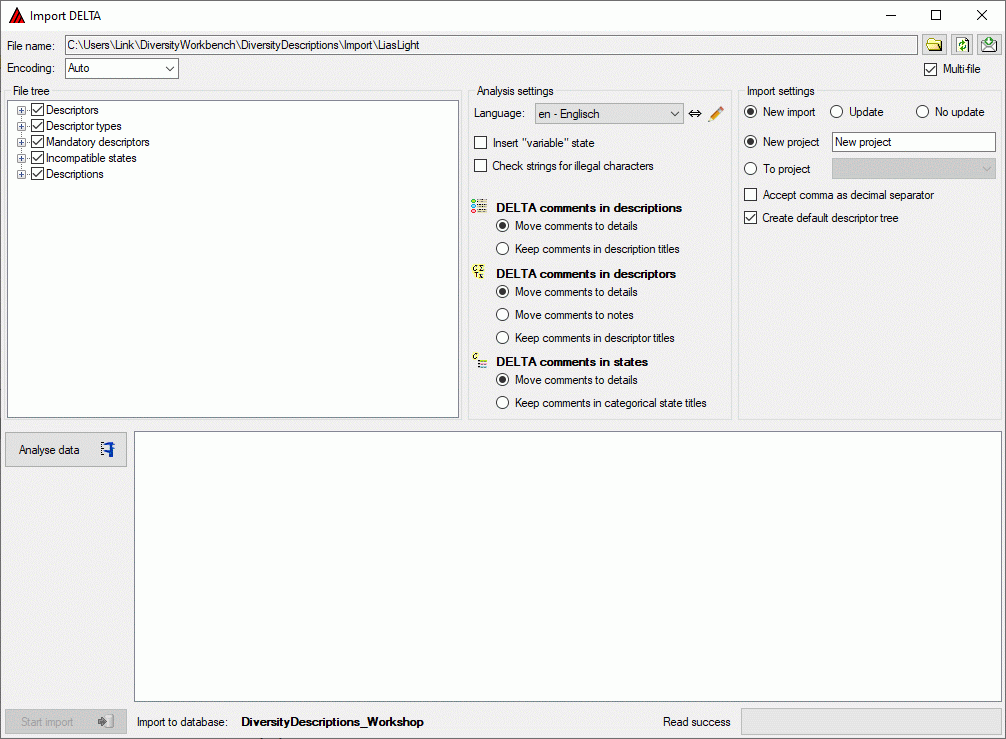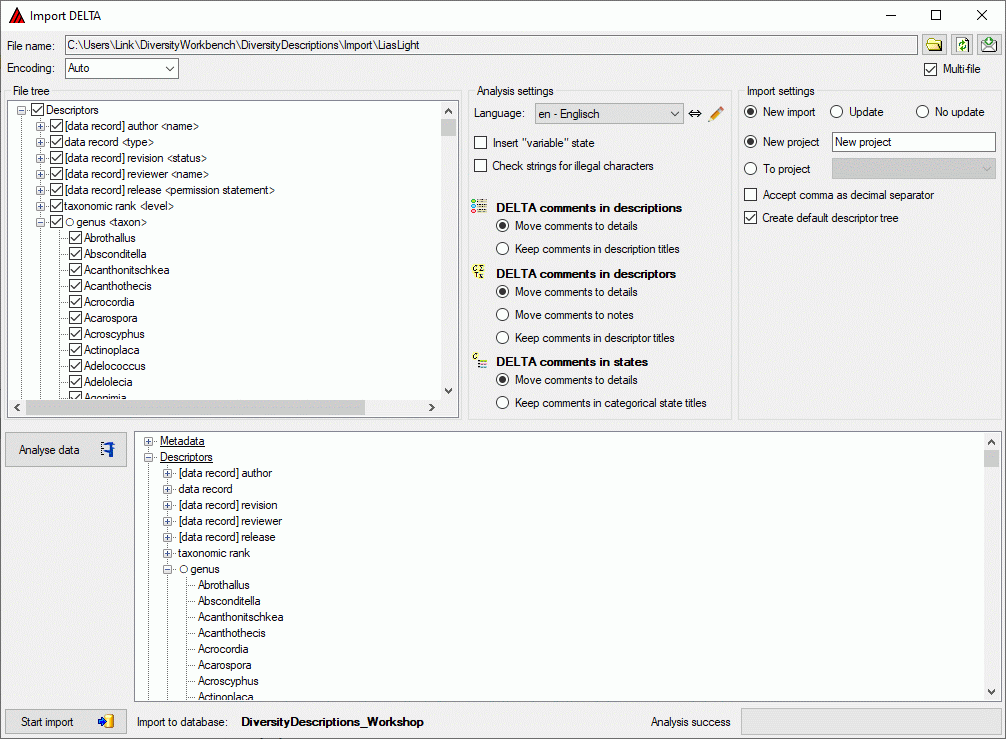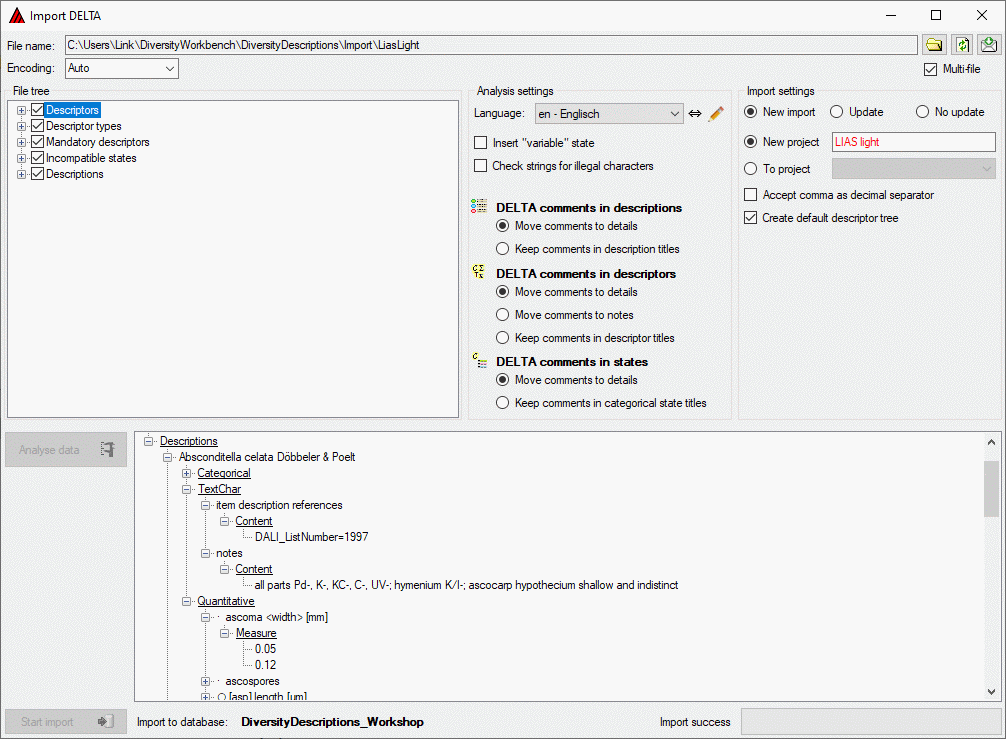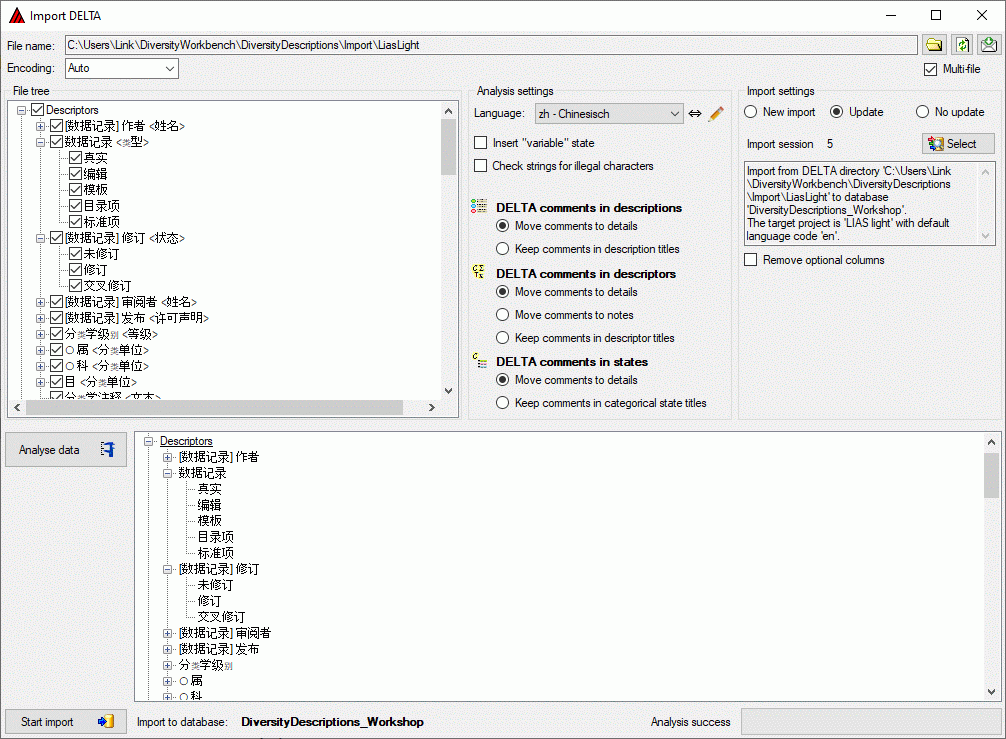Import DELTA file
Remark:
- To import data from a DELTA file at least TerminologyEditor
rights are neccessary.
With this form you can import data from a file in DELTA format into the database. Choose
Data ->
 Import ->
Import ->
 Import DELTA ... from the menu to open the window for the import.
In the window click on the
Import DELTA ... from the menu to open the window for the import.
In the window click on the
 button to select the file with the data you want to import. If the Multi-file
option is selected before pressing the
button to select the file with the data you want to import. If the Multi-file
option is selected before pressing the
 button, a folder selection window opens to select the folder where the DELTA files
are located. For muti-file processing currently the files "chars", "items",
"specs" and "extra" are evaluated. If during analysis or import
any problems occur, you may click on the
button, a folder selection window opens to select the folder where the DELTA files
are located. For muti-file processing currently the files "chars", "items",
"specs" and "extra" are evaluated. If during analysis or import
any problems occur, you may click on the
 button to reload the file and re-initialize the window.
button to reload the file and re-initialize the window.

The contents of the file will be shown in the upper part
of the File tree section. If special characters are not displayed corretly,
try a different Encoding setting, e.g. "ANSI", and reload
the document using the
 button. In the bottom part of the window you find the import database and the actual
processing state.
button. In the bottom part of the window you find the import database and the actual
processing state.
In the file tree you may deselect entries that shall not
be imported into the database. Use that option very carefully, because if you deselect
entries that are being referenced by other parts of the input tree, e.g. descriptors
referenced by descriptions, the analysis or import step might become erronous!
If during reading of the files expressions cannot be interpreted,
suspicious entries are maked with yellow background (warning)
in the file tree. When you move the mouse curser over the marked entries, you get
additional information as tool tip or the tree node text itself tells the problem
(see example below).

Analysis
To analyse the data in the file click on the Analyse
data
 button. During
the analysis the program checks the dependencies between the different parts of
the data and builds up an analysis tree in the lower part of the window. The analysis
tree contains all data in a suitable format for the final import step. During data
analysis the icon of the button changes to
button. During
the analysis the program checks the dependencies between the different parts of
the data and builds up an analysis tree in the lower part of the window. The analysis
tree contains all data in a suitable format for the final import step. During data
analysis the icon of the button changes to
 and you may abort processing by clicking
the button.
and you may abort processing by clicking
the button.
In the Analysis settings section (see image below)
you set the document's Language. You man change the display
and sorting of the entries in the Language combo box from "<code>
- <description>" to "<description> - <code>" (and
back) by clicking the button
 . If you need language codes that are not included
in the list, click the
. If you need language codes that are not included
in the list, click the
 button. For more details see Edit language codes.
button. For more details see Edit language codes.
The Insert "variable" state
controls the handling of the DELTA state "V" for categorical summary data.
If possible, a categorical state "variable" is inserted to the descriptor
data and set in the summary data, when the state "V" is present in the
description data.
If the Check strings for illegal characters
option is checked, all string literals that shall be exported from database
are scanned for illegal non-printable characters and matches are replaced by a double
exclamation mark ("‼"). Activating this option may increase the analysis
processing time.
In DELTA text in angle bracket (<text>) usually
denotes comments, which are by default imported into the "Details" fields
of the database. In the lower parts of the Analysis settings you
may adjust a different handling for description, descriptor and categorical state
items.
- For DELTA comments in descriptions
you may Move comments to details (default) or Keep comments
in description titles.
- For DELTA comments in descriptors
you may Move comments to details (default), Move comments to
notes or Keep comments in descriptor titles.
- For DELTA comments in categorical states
you may Move comments to details (default) or Keep comments
in categorical state titles.
After changing one of these settings click on the
Analyse data
 button to
make the changes effective.
button to
make the changes effective.

After analysis a message window informs you if any warnings
or errors occured. You can find detailled error and warning information at the file
and/or analysis trees by entries with red text (error)
or yellow background (warning). When you move the mouse
curser over the marked entries, you get additional information as bubble help or
the tree node text itself tells the problem (see example below). By clicking on
the status text besides the progress bar, you can open an analysis protocol (see
below, right).


If an analysis error occured, you are not able to proceed.
You will first have to correct the problem, e.g. by excluding the erronous descriptor
in the example above (after reloading the file). If a warning occured, it might
not cause problems during import, but you should take a closer look if the imported
data will be correct.
Import
If you want to import new data to a project you have two
import options:
- New import - import new data and save mapping
information to an import session.
For descriptors, categorical states and descriptions the mapping information from
the DELTA import will be storen in an import session.
Therefore by a subsequent import run updated information, e.g. a modified label
or detail information can be done (see section "Update" below).
- No update - import new data without saving
of mapping information.
This option might be faster, but you will not be able to update the titles or to
import additional translations from a DELTA file.
Before starting the import, you should take a look at
the import settings:
- New project - import data to a new project.
The project name is specified in the text box right from this radio button.
This option is only available if at least ProjectManager rights are available.
- To project - import data to an existing project.
The combo box at the right shows all projects where write access is possible.
If only TerminologyEditor rights are availabe, no changes in the existing project
(e.g. detail or copyright) will be done.
- Accept comma as decimal separator shall help
to overcome problems with localization of some programs that create DELTA files.
If this option is checked, a floating point value like "1,0" (e.g. used
in german localizations) instead of "1.0" will be accepted as "1".
- Create default descriptor tree creates a default
descriptor tree and assigns all imported descriptors to that tree.
Additionally the statistical measures "Minimum", "Lower limit",
"Mean", "Upper limit" and "Maximum" are set as recommended
for all quantitative descriptors.
This option is useful to avoid unassigned descriptors if the import file does not
specify any descriptor tree assignments.
To start the import click on the Start import
 button. Now
the data from the analysis tree are written into a local database cache and finally
stored into the database.
button. Now
the data from the analysis tree are written into a local database cache and finally
stored into the database.

After import a message window inform you if any warnings
or errors occured. You can find detailled error and warning information at the file
and/or analysis trees by entries with red text (error)
or yellow background (warning). When you move the mouse
curser over the marked entries, you get additional information as bubble help or
the tree node text itself tells the problem. By clicking on the status text besides
the progress bar, you can open an import protocol (see below).

Handling of special
DELTA states
In the DELTA format the special states "-"
(not applicable), "U" (unknown) and "V"
(variable) are available for categorical and quantitative characters. These states
are treated in the folloging manner during import:
- "-" (not applicable)
The data status "Not applicable" is set.
- "U" (unknown)
The data status "Data unavailable" is set.
- "V" (variable)
The data status "Not interpreterable" is set.
Update
If you imported new data using option New import,
a new import session with the following data will be created:
- Descriptor keys - the "character number"
that is used in DELTA to identify a dedicated character.
- Categorical state keys - the "state number"
that is used in DELTA, together with the "character number", to identify
a dedicated chategorical state.
- Description keys - the item position in the
item list. Since in DELTA there are no explicit item numbers, the position within
the item list is taken for this key. If you want to update the items using the DELTA
import, you must be sure that the item list has exactly
the same sequence as for the first import!
For those entities you may update the columns "label",
"detail" and "data_entry_notes" (only for descriptors). To achive
this, you must specify the same Language in the Analysis settings
as adjusted as project language. If you specify a different Default language,
the data will be imported as translations for the columns "label" rsp.
"detail" (see image below). For descriptor column "data_entry_notes"
translations are not supported.

Preparation
By changing the Analysis settings and
a clicking the Analyse data
 button
you may modify the handling of DELTA comments. E.g. if you used the default settings
during a past import, a DELTA character "data record <type>" was
imported as descriptor "data record" and "type" was written
into the columns "detail". In the Analysis settings
you may now select option Keep comments in descriptor titles to
update the descriptor title to "data record <type>".
button
you may modify the handling of DELTA comments. E.g. if you used the default settings
during a past import, a DELTA character "data record <type>" was
imported as descriptor "data record" and "type" was written
into the columns "detail". In the Analysis settings
you may now select option Keep comments in descriptor titles to
update the descriptor title to "data record <type>".
Import settings
Before starting the import, you should take a look at
the import options:
- Update - perform an update import.
- Import session - click on button
 Select to select the correct import session.
Select to select the correct import session.
In the text box below that option the automatically generated descriptive text of
the import session is displayed.
- Remove optional columns - clear optional columns
if no contents is present.
If during update import for an optional column ("detail" rsp. "data_entry_note")
no data are present, by default an existing entry in the database will not be removed.
Check this option to clear the data.
Start the import click on the Start import
 button. Now
the data from the analysis tree are written into a local database cache and finally
stored into the database.
button. Now
the data from the analysis tree are written into a local database cache and finally
stored into the database.
 Import ->
Import ->
 Import DELTA ... from the menu to open the window for the import.
In the window click on the
Import DELTA ... from the menu to open the window for the import.
In the window click on the
 button to select the file with the data you want to import. If the Multi-file
option is selected before pressing the
button to select the file with the data you want to import. If the Multi-file
option is selected before pressing the
 button, a folder selection window opens to select the folder where the DELTA files
are located. For muti-file processing currently the files "chars", "items",
"specs" and "extra" are evaluated. If during analysis or import
any problems occur, you may click on the
button, a folder selection window opens to select the folder where the DELTA files
are located. For muti-file processing currently the files "chars", "items",
"specs" and "extra" are evaluated. If during analysis or import
any problems occur, you may click on the
 button to reload the file and re-initialize the window.
button to reload the file and re-initialize the window.


 button. During
the analysis the program checks the dependencies between the different parts of
the data and builds up an analysis tree in the lower part of the window. The analysis
tree contains all data in a suitable format for the final import step. During data
analysis the icon of the button changes to
button. During
the analysis the program checks the dependencies between the different parts of
the data and builds up an analysis tree in the lower part of the window. The analysis
tree contains all data in a suitable format for the final import step. During data
analysis the icon of the button changes to
 and you may abort processing by clicking
the button.
and you may abort processing by clicking
the button.
 . If you need language codes that are not included
in the list, click the
. If you need language codes that are not included
in the list, click the
 button. For more details see
button. For more details see 





 Select to select the correct import session.
Select to select the correct import session.